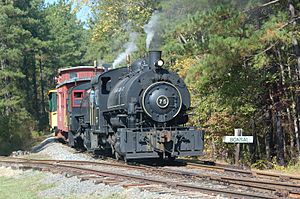New Hope Valley Railway facts for kids
| Triangle's Train | |
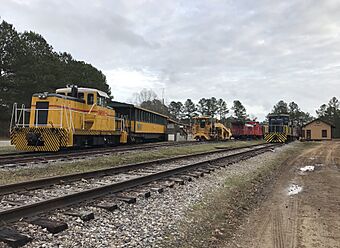
New Hope Valley Railroad museum train cars and locomotives
|
|
| Overview | |
|---|---|
| Headquarters | Bonsal, North Carolina |
| Reporting mark | NCRM |
| Locale | New Hill, North Carolina |
| Dates of operation | 1982–present |
| Technical | |
| Track gauge | 4 ft 8 1⁄2 in (1,435 mm) standard gauge |
| Length | 4 miles (6.4 km) |
The New Hope Valley Railway (reporting mark NCRM), also known as the Triangle's Train, is a special kind of train line. It's a heritage railroad located in Bonsal, North Carolina. This railway is run by the North Carolina Railway Museum, Inc. This museum is a group of volunteers who love trains. They are a non-profit organization that teaches people about train history.
The railway has about five miles of track. It connects the towns of Bonsal, North Carolina and New Hill, North Carolina.
The North Carolina Railway Museum is in Bonsal, North Carolina. It has a cool collection of old train cars and other train items. You can also see a large model train layout there.
Contents
The Story of the Railway
The idea for this train line started way back in 1904. It was first called the New Hope Valley Railroad. In 1905, it joined with another company, the Durham & South Carolina Railroad. This happened before any tracks were even built!
Building the Line
The Durham & South Carolina Railroad (D&SC) built the tracks between 1905 and 1906. They wanted to reach the timber (wood) resources in the New Hope Creek valley. The line connected several towns. These included Bonsal, North Carolina, Beaver Creek, North Carolina, and Durham, North Carolina. In Durham, it was the only train line that could reach the American Tobacco Company. This was important for moving tobacco products.
Expanding and Changing Hands
The train line grew longer between 1911 and 1913. It went south from Bonsal to Duncan, North Carolina. There, it connected with the "old" Norfolk Southern Railroad. In 1920, the Norfolk Southern Railroad leased the D&SC line. This gave them a way to reach Durham, North Carolina. A new track was built in Durham in 1925. It served a new American Tobacco Company factory.
A New Path and a New Name
The North Carolina Railway Museum started in 1963. It was first known as the East Carolina Chapter of the National Railway Historical Society. In the 1970s, the train line had to be rebuilt. This was because the B. Everett Jordan Dam was constructed. This dam created Jordan Lake, which covered the old tracks.
A six-mile section of the line was sold in 1982. It went to the East Carolina Chapter, NRHS. This group then formed the New Hope Valley Railway. In 2008, this organization changed its name. It became the North Carolina Railway Museum, Inc.
The northern part of the original railway is now a trail. It's called the American Tobacco Trail. The southern part is near the Shearon Harris nuclear power plant.
Fun Train Rides
The New Hope Valley Railway offers fun passenger train rides. These "excursion trains" run every month. You can ride them from April all the way to December. They also have special trains for holidays. For example, they run special Halloween trains in October. They have many other themed train rides throughout the year.
Drive a Train!
The New Hope Valley Railway has a unique program. It's called "Operate-a-Loco." On certain Saturdays and Sundays, you can actually drive a real diesel train! You need to be over 18 and have a valid driver's license. A trained engineer will guide you along the four miles of track. This means an eight-mile round trip. The railway provides all the equipment you need.
How the Railway Works
The railway is completely run by volunteers. These dedicated people are part of the North Carolina Railway Museum. This museum used to be called the East Carolina Chapter of the National Railway Historical Society until 2008. The railway is also a member of the HeritageRail Alliance. This is a group that supports historic railways.
Train Equipment
The New Hope Valley Railway has many different trains. These include locomotives (the engines that pull the trains) and other train cars.
Locomotives
| No. | Image | Type | Class | Builder | Built | Status |
|---|---|---|---|---|---|---|
| 110 | 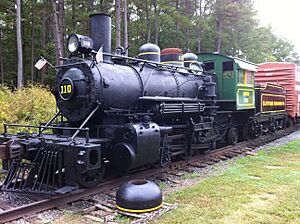 |
Steam | 2-6-2 | Vulcan Iron Works | 1927 | Under restoration |
| 17 |  |
Steam | 0-4-0 | Vulcan Iron Works | 1941 | Undergoing 1,472-day inspection and overhaul |
| 1686 | 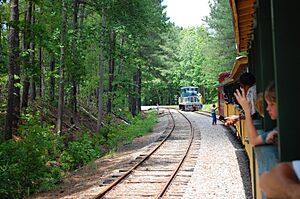 |
Diesel | 80-ton switcher | General Electric | 1953 | Operational |
| 399 |  |
Diesel | 65-ton switcher | General Electric | 1943 | Operational |
| 70 | Diesel | 45-ton switcher | Geo D. Whitcomb Company | 1941 | Inoperable | |
| 10 | 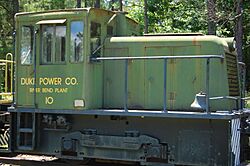 |
Diesel | 25-ton switcher | General Electric | 1950 | Inoperable |
Rolling Stock
These are the other cars that trains pull, like passenger cars or cabooses.
| No. | Image | Type | Builder | Built | Status |
|---|---|---|---|---|---|
| 308 | Caboose | N/A | N/A | Operational | |
| 328 | Caboose | N/A | 1949 | Operational | |
| 302 | Caboose | N/A | N/A | Operational | |
| 309 | Caboose | N/A | N/A | Operational | |
| 5228 | 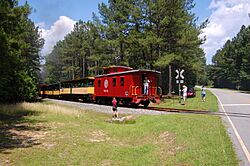 |
Caboose | N/A | 1926 | Operational |
| 6929 | Passenger Car | Budd Company | 1958 | Under restoration |


